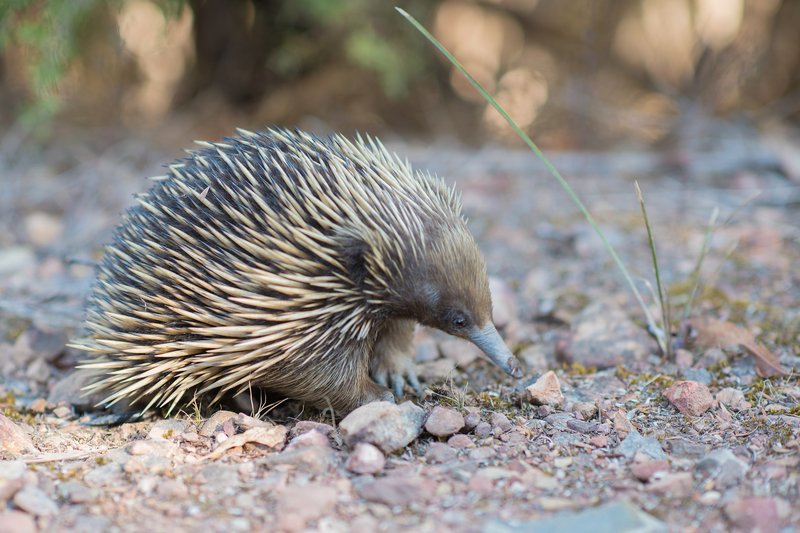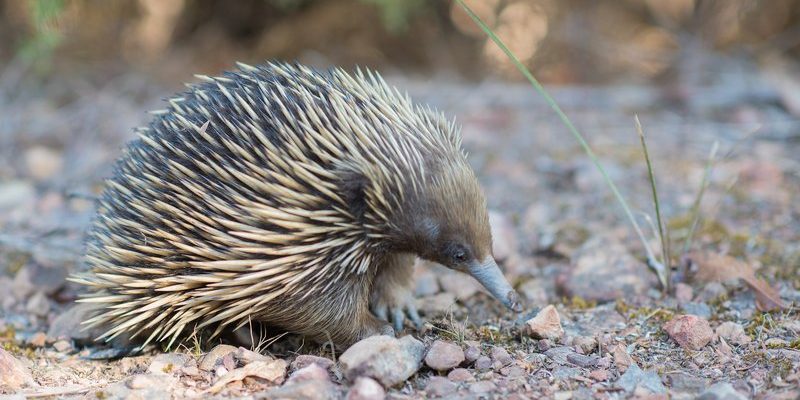
Imagine a creature that looks like a walking pinecone—that’s the echidna for you! These fascinating mammals are a part of the monotreme family, meaning they lay eggs instead of giving birth to live young, which is a rarity in the mammal world. With their spiky coats and adorable snouts, echidnas are truly one of nature’s quirkiest wonders.
Not only are they unique in appearance, but they also have interesting behaviors and adaptations that help them thrive. Echidnas are primarily found in Australia and New Guinea, roaming through forests, mountains, and even urban areas. Let’s dive deeper into the world of echidnas, exploring their habitat, diet, behavior, and more. You’ll come to appreciate just how incredible these little creatures are!
Characteristics of Echidnas
Echidnas have *some striking characteristics* that set them apart from other animals. With their spiky, quill-like spines made of keratin, they resemble porcupines. However, these aren’t just for show. The spines act as a defense mechanism against predators. When threatened, an echidna can curl up into a ball, making it hard for foes to get a grip. This neat trick is a part of what makes them so endearing and interesting.
In terms of size, echidnas are relatively small, typically measuring between 12 to 18 inches in length. Their snouts are long and tubular, perfect for foraging insects, which are their primary food source. That’s right! Echidnas are insectivores, and their diet mainly consists of ants and termites, which they find by using their keen sense of smell. With a sticky tongue that can be up to four inches long, they can quickly get to their food. And they can eat a surprising amount—up to 20,000 ants in a single day!
Another interesting fact is that echidnas have a low body temperature compared to other mammals. Their average temperature hovers around 90°F (32°C), which is quite cool. This unique characteristic is likely an adaptation to conserve energy. In the wild, you’ll often find echidnas resting in shady spots during the hottest part of the day, coming out to forage in the cooler evenings.
Echidna Habitat and Distribution
Echidnas inhabit a variety of environments, from forests and shrublands to grasslands. They prefer cooler habitats and can often be found in areas with plenty of vegetation. Interestingly, they can also adapt to urban settings if there’s enough food available. This adaptability showcases their resilience and ability to thrive in various conditions.
Geographically, echidnas are found across Australia and New Guinea, with their distribution influenced by environmental factors. In Australia, the short-beaked echidna is the most common species, while in New Guinea, you’ll find both the short-beaked and the long-beaked varieties. The long-beaked echidnas are more specialized creatures with a unique set of adaptations suited for their specific habitats.
Due to their adaptability, echidnas can be found at different elevations, ranging from sea level up to mountainous regions. In fact, they’ve been spotted at altitudes of over 11,000 feet! By exploring various habitats, echidnas play important roles in their ecosystems, such as controlling insect populations and contributing to soil health.
Diet and Feeding Habits
As mentioned earlier, echidnas are primarily insectivorous, meaning their diet consists mostly of bugs. They mainly feast on ants and termites, but they’ll also munch on other insects when the opportunity arises. Echidnas have evolved a range of feeding techniques to help them find and consume their food. For instance, they can dig into ant mounds with their strong claws or use their long snouts to probe into the ground.
When searching for food, they rely heavily on their keen sense of smell. This allows them to sniff out food buried under the surface, making it easier to find their next meal. Once they’ve located their food, they dart in with their sticky tongue, quickly capturing their prey. Their specialized digestive systems help them extract the nutrients they need from their meals, including the tough exoskeletons of insects.
Interestingly, echidnas don’t typically drink water like many other animals. Instead, they obtain moisture from the food they eat. Also, their bodies are efficient at saving energy, which means they don’t require as much food as you might expect given their active nature. This makes them quite unique in the animal kingdom and showcases their distinct adaptations for survival.
Breeding and Life Cycle
Echidnas have an interesting breeding process that sets them apart from most mammals. When the mating season arrives, male echidnas will compete for the attention of females. They’ll engage in a behavior known as “cocoa,” where multiple males will follow a single female for a few days in hopes of mating. After mating, females lay one to three eggs, which are soft and leathery, similar to reptile eggs.
Once the eggs are laid, the female will incubate them in a special pouch. After about ten days, the eggs hatch, and the tiny echidna pups—called “puggles”—are born. These little ones are incredibly vulnerable, being blind and hairless at birth. They stay in their mother’s pouch for about eight weeks, feeding on milk until they’re ready to venture out into the world.
As the puggles grow, they develop spines, which start to emerge after about three weeks. They remain with their mother for several months before becoming fully independent. In the wild, echidnas have a lifespan of around 10-16 years. However, in captivity, they can live up to 50 years, thanks to better care and fewer threats. It’s a fascinating life cycle that showcases the resilience and adaptability of these remarkable creatures.
Threats and Conservation
Despite their resilient nature, echidnas face several threats in the wild, mainly due to human activities. Habitat destruction, caused by deforestation and urbanization, has impacted their natural living spaces. As their habitats shrink, they struggle to find food and shelter, leading to declining populations in some areas.
Additionally, echidnas are vulnerable to road accidents, as they often wander onto roads in search of food. Climate change poses another significant threat, altering their environment and impacting their food sources. As temperatures rise and ecosystems shift, echidnas may find it more difficult to adapt and survive.
Thankfully, conservation efforts are underway to protect these unique animals. Many organizations work to preserve their habitats and raise awareness about the importance of echidnas in ecosystems. By focusing on conservation, we aim to ensure that future generations can continue to marvel at these spiny wonders of nature.
Interesting Facts About Echidnas
| Common Name: | Echidna |
| Scientific Name: | Tachyglossus |
| Size: | 12-18 inches long |
| Weight: | 4-10 lbs |
| Habitat: | Forests, grasslands, urban areas |
| Diet: | Insects (mainly ants and termites) |
| Lifespan: | 10-16 years in the wild, up to 50 years in captivity |
Echidnas in Culture
Echidnas aren’t just fascinating to scientists; they also hold a special place in various cultures. For many Indigenous Australian peoples, the echidna is a significant figure in their mythology and storytelling. These adorable creatures are seen as symbols of resilience and strength. In Aboriginal Dreamtime stories, echidnas often feature in tales that explain their unique traits and behaviors.
In addition to mythology, you might find echidnas appearing in local art or crafts, emphasizing their cultural importance. Their quirky appearance makes them a popular subject for artists, reflecting the beauty and uniqueness of native wildlife. They are celebrated not just for their distinct characteristics but also for their roles in maintaining ecological balance.
In modern times, echidnas gained popularity through various media, from documentaries to children’s books, fostering curiosity and awareness about these fascinating animals. As more people learn about echidnas and their significance, ongoing conservation efforts become increasingly vital to ensure their survival for future generations.
FAQ
What is an echidna’s primary habitat?
Echidnas primarily inhabit forests, grasslands, and shrublands. They are also capable of adapting to urban environments where food is available. Their ability to thrive in different climates demonstrates their resilience and adaptability.
How do echidnas defend themselves?
Echidnas have a unique defense mechanism; they curl into a ball when threatened. Their spiny backs make it harder for predators to attack. Additionally, their ability to dig quickly into the ground also helps them escape dangers. This combination of physical features keeps them safe in the wild.
What do echidnas eat?
Echidnas primarily consume ants and termites, using their long, sticky tongues to catch their prey. They can also eat other insects. Interestingly, they do not need to drink water as they get most of their hydration from the food they eat, making them quite efficient foragers.
How long do echidnas live?
In the wild, echidnas typically live for about 10 to 16 years. However, in captivity, they can live significantly longer—up to 50 years—thanks to better care and fewer threats from their environment. Their longer lifespan in captivity highlights the challenges they face in the wild.
Are echidnas endangered?
While echidnas as a species are not listed as endangered, they do face threats such as habitat loss, climate change, and road accidents. Conservation efforts are crucial to protect their habitats and ensure they continue to thrive in the wild.
Do echidnas have any predators?
Echidnas have a few natural predators, including dingoes and large birds of prey. However, their primary defense mechanism—curling into a ball and using their spines—helps them avoid many potential threats. In urban environments, vehicles are a significant threat to their safety.
Can echidnas be kept as pets?
It’s not advisable to keep echidnas as pets. They are wild animals with specialized needs that are difficult to meet in captivity. Furthermore, they have specific dietary requirements and space needs that make them unsuitable for domestic life. Respecting their natural habitat is the best way to support echidnas.
What is the difference between short-beaked and long-beaked echidnas?
The primary difference lies in their physical characteristics and habitats. Short-beaked echidnas are found in Australia, while long-beaked echidnas reside in New Guinea. Long-beaked echidnas have more elongated snouts and specific adaptations that make them suited for their environment, whereas short-beaked echidnas are more commonly recognized.
How do echidnas reproduce?
Echidnas reproduce by laying eggs, which is quite unusual for mammals. After mating, females lay soft, leathery eggs in a pouch. The eggs hatch after about ten days, and the tiny puggles will stay in the pouch for several weeks before they are ready to venture outside.
What role do echidnas play in their ecosystems?
Echidnas play a vital role in controlling insect populations in their habitats. By feeding on ants and termites, they help maintain ecological balance. Their digging also aerates the soil, contributing to soil health and promoting plant growth. This ecological role underscores the importance of conserving their populations and habitats.

